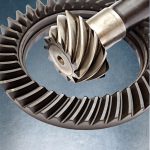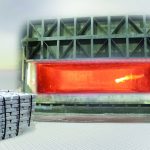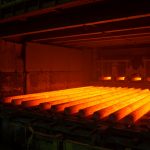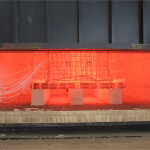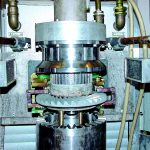What is deep cryogenic treatment? Deep cryogenic treatment (DCT) of steels and other materials is a distinct process that uses the application of extreme cold applied with distinct time/temperature profiles to modify the performance of materials. This process is also referred to as cryogenic processing, cryogenic tempering, deep cryogenic treatment, deep cryogenic tempering, and deep cryogenic processing. What are cryogenic temperatures? The scientific community generally defines cryogenic temperatures as temperatures below -150°C (-238°F or 123°K). This is, admittedly, an artificial upper limit; temperatures used presently in cryogenic treatment are generally -185°C (-300°F or 89°K). DCT is often confused with cold treating, a process used on hardened steel to reduce retained austenite. DCT is differentiated from cold treatment by the use of cryogenic temperatures, having distinct time/temperature profiles, and by its applicability to materials other than steel.
Go to a metallurgical conference and start talking about cryogenic processing and you will get some very interesting conversations. Amid cries of “Snake oil!” and “Get the tar and feathers!” you will have some quiet voices telling you that they use DCT to vanquish their competitors. Indeed, during the writing of this paper, disparaging remarks about DCT were made on a conference call of metallurgists who were planning a metal treating conference. And this was the same group that was told earlier that a webinar about DCT scored the biggest number of participants and the most questions in this organization’s webinar history. So what is it about this process that creates such differing opinions? Are those that swear by the process alchemists, sorcerers, wizards, shamans, and enchanters? Are dark forces called into play to get the reported results? Are those who specify DCT delusional victims of placebo effects hoping to find some meager advantage that will show the world that they too can be smart? And what of those who disparage DCT? Are they intelligent scientists who know a con when they see it? How can reducing the temperature of a solid change it? Why does this process polarize the materials science community?
There are many reasons for the above behavior. Until recently, DCT was an empirically developed process. It is common wisdom that heat changes things, but cold frozen things are, well, frozen. Humans have been using heat to modify metals for over 7,000 years. We’ve only had cryogenic temperatures in useful quantities for a little over 100 years, so our cultural and scientific knowledge of cryogenic cold is limited. DCT has only been around since the late 1930s, where it was developed for use on aircraft engines in Germany, and independently in the United States for use on knives. There was generally a lack of research about the process; what research existed centered on the validity of the process’s results. Even with the careful research of Dr. Randall Barron, the metallurgical community did not recognize the process.
Another reason for the problems was inflated claims of what could be done with DCT. Early practitioners advertised that treated engines would get 120 miles per gallon, that nobody had ever had a treated engine fail, and that the process increased the tensile strength of steel ten times. These claims did terrible damage to the process’s reputation. A corollary to the inflated claim problem was that DCT actually does give results that seem inflated. A study of five metals by Dr. Barron showed that, while cold treating increased wear resistance by factors of 1.2 to 2.0, DCT increased wear resistance on the same metal/heat treat combination by factors ranging from 2.0 to 6.6 (Barron, 1984). Also, the use of DCT on metals other than heat-treated steel drew scorn even though research showed good results with most metals, cemented carbides, and some plastics (Kalia, 2010) (Stewart, 2004) (Yong, 2006). Brake rotors do show a two to seven times increase in life when tested in the laboratory even though their microstructure is pearlitic and they have no austenite. In real life use, they consistently last three times longer than untreated rotors even under racing conditions.
The assumption that DCT is the same as cold treatment has also skewed some of the research. Cold treatment involves inserting the component to be treated into the cold temperature. This has led researchers to immerse components to be DCT treated directly into liquid nitrogen. However, DCT involves lowering the temperature of the component slowly, holding it there for a period of time, and then warming it slowly to ambient temperature. One or more tempering cycles may follow.
Immersion has been shown to be mostly useless. It does not allow time for the changes in the crystal structure to occur and can cause severe stress in the part being treated. The timing is critical. Some research is being done to optimize the profiles for individual steels. For instance, some research indicates the holding time for AISI T42 steel should not be longer than eight hours (C. L. Gogte, 2010). In contrast, research indicates that the hold time should be 36 hours for AISI D2 (D. Das, 2009). The point is this: Like heat treating, the process must be done correctly for good results.
What Does DCT Do To Metals?
There are several theories concerning reasons for the effects of cryogenic treatment. One theory involves the more nearly-complete transformation of retained austenite into martensite. This theory has been verified by x-ray diffraction measurements. Another theory is based on the strengthening of the material brought about by precipitation of submicroscopic carbides as a result of the cryogenic treatment (Collins, 1998) (Fanju Meng, 1994). Allied with this is the reduction in internal stresses in the martensite that happens when the submicroscopic carbide precipitation occurs. A reduction in micro cracking tendencies resulting from reduced internal stresses is also suggested as a reason for improved properties. Studies also show reduction in residual stresses.
Another area to consider is the basic effect of cold on the crystal structure of metals. Point defects in the crystal structure are temperature-dependent. Lowering the temperature of the crystal structure will cause the number of point defects in the crystal structure to change according to the equation:
Nd = N exp(-Ed/kT)
Nd is the number of defects present, N is the total number of atomic sites, Ed is the activation energy needed to form the defect, k is the Boltzmann constant, and T is the absolute temperature. Reducing the temperature at a suitably slow rate drives the point defects out of the structure to the grain boundaries. In other words, the solubility of vacancies and other point defects in the matrix drops. Note that the rate of descent of the temperature needs to be suitably slow for this to happen.
Another theory is that there is a discreet distance between atoms in a crystal structure that is associated with the lowest energy state in the metallic bond. Crystals that have all the atoms at this exact distance are stronger and therefore more wear-resistant. By reducing the temperature slowly, we take the extra energy out of the atom-to-atom bond and, when gently warmed up, more of the atoms are at the ideal distance from each other.
It is likely that the results achieved with DCT are due to a combination of all of the above factors. More research is needed to determine how much each factor contributes. Knowing how much each factor contributes to the results of DCT would be of great help in optimizing it for any given situation. That being said, the results of DCT are so significant that using it can give huge competitive advantages.
What Does This Mean To Gear Makers?
DCT is valuable to the gear industry in two major areas: product and tooling. A study conducted by the Illinois Institute of Technology Research Institute for the US Army Aviation and Missile Command concluded that DCT created 50% more pitting resistance life and 5% more load-carrying capacity on 9310 steel than cold treating. It also noted that DCT raised the tempering temperature of the metal (Swiglo, 2000).
Further studies conclude that the wear resistance of cold-treated EN353 is increased 85% over conventionally heat-treated steel; but DCT showed an increase of 372% (Bensely, 2005). Studies of the impact strength of the same material show that it is increased by DCT to a similar extent as with cold treatment (A. Prabhakaran, 2004). Of note in studies of EN353 is that the samples were subjected to DCT directly after quench with no snap temper. It would be interesting to see what a safety temper after quenching but before DCT would accomplish on the same steel.
Most work performed on gears until now has been done in the racing industry, where OEM gears and shafts are treated long after they were manufactured. Although racing is not a good means of scientific testing since every race is different, our customers consistently report about a three times life increase on treated transmissions. We’ve found that one must take the type of race into account, as drag racing imparts very sudden shock loads, whereas track racing creates more wear. Tempering temperatures must therefore be adjusted. Although this is not scientific, considering all variables are controlled, real-world experience shows that the reliable final result is one of major life increase. The ability to withstand the vagaries of actual use is a testament to the value of DCT. We treat transmission components for racing transmission manufacturers who use them in their standard products.
Tooling
Perishable tooling is a major cost in manufacturing. DCT has been used for years on both HSS and carbide cutting tools. Many studies are available that show the value of DCT in making tool steels more wear-resistant and tough, resulting in reduced costs. One study on both M2 steel and H13 steel predicts a 50% decrease in tooling costs (Molinari, 2001). Industrial tests have shown tremendous increases in life. Like racing, the ability to control all parameters is limited, but again, the world outside the laboratory is the world we live in.
Carbide has been shown to undergo a phase change when DCT is applied, which makes it more wear-resistant. It was noted that if the tool is allowed to become hot while cutting, the phase would change back to “normal.” This is a good indication as to why interrupted cuts with DCT-treated carbide tooling were always successful (Yong, 2006).
Grinding wheels also show particular increases in life. We are only now getting into laboratory tests as to why diamond wheels and CBN wheels show increases in life up to ten times. Grinding is an important field of study, in that the variables of grinding have to be very carefully controlled in order to avoid inducing tensile residual stresses into the part being ground. Increasing the wheel life without affecting the other parameters could lead to significant cost reductions along with maintaining the integrity of the part being ground.
Equipment
All cryogenic processing equipment is comprised of a thermally insulated container and some means of extracting the latent heat of the payload to reach the desired low temperature. In most cases the insulation is a solid material that contains small closed cells of trapped still air. The thermal conductivity of such insulation is essentially that of still, non-convecting air, assuming that the solid material that encloses the air pockets is of thin cross-section and low conductivity. Examples are polyurethane foam, aerogel, and expanded glass foam. Six inches of any of these will conduct approximately 15 BTU/hr.ft2 across a temperature differential of 400ºF, which exists between the interior of a refrigerator at –320ºF and an ambient temperature of +80ºF.
These solid insulating materials are relatively inexpensive and, in the case of foamed in place polyurethane, can readily fill irregularly-shaped cavities. They all suffer from one important drawback. Temperature cycling establishes a temperature gradient across the insulating slab, which results in differential contraction in the material. Repeated temperature cycles ultimately result in fatigue cracking of the insulation. Energy expenditure to sustain the temperature difference goes up, and temperature uniformity within the refrigerator may deteriorate.
The use of vacuum insulation in cryoprocessor design avoids these problems. A vacuum insulated container consists of two concentric shells, usually cylindrical, separated by a small distance relative to their diameters, which are joined around the perimeter of one end of the shells. The space between the shells contains reflective insulation and is evacuated to a pressure of about 10-6 torr. This essentially eliminates heat flow by conduction and convection because most of the conducting or convecting gas has been removed. Heat gain via infrared radiation is minimized by multiple reflective layers placed in the vacuum space. Heat flow across a vacuum insulated space, given a temperature difference across the walls of 400ºF, is 0.008 BTU/hr.ft2, a factor of 1900 better than solid insulation of 6” thickness (Jeffrey Levine, 2001). The principal mode of heat transmission into the interior of a vacuum insulated container is metallic conduction through the perimeter that joins the inner and outer shells.
In addition to providing a barrier to flow relative to solid insulation, the vacuum insulated vessel is immune to thermal cycling fatigue. Additionally, the vacuum insulated vessel can sustain elevated operating temperatures far in excess of that permissible with the use of polyurethane. This permits the post-refrigeration tempering of components in one device, eliminating the need for a separate tempering oven.
Heat extraction from the payload is affected by the phase change of a low boiling-point fluid. If mechanical refrigeration is used, a high-pressure fluid is allowed to expand and become a gas within an evaporator coil inside the insulated space. The evaporator coil is a heat exchanger, which absorbs heat from the payload via convection, natural or forced, within the chamber. This ensures the relatively slow cooling of the payload and avoids thermal shock resulting from a too rapid cooling. Rapid cooling can cause shrinkage of the outside of the cooled component while the relatively warm interior is not shrinking. Tensile stress induced this way can lead to cracking or the initiation of residual stress, especially at sharp edges. Reaching cryogenic temperatures by mechanical refrigeration for industrial size payloads requires multistage refrigeration. These are very expensive machines to build and maintain.
Fortunately, liquid nitrogen is abundant, readily available, and relatively inexpensive. It has a boiling point of -321º F, and a heat of vaporization of about 150 BTU/liter. It is produced in huge industrial gas production facilities and delivered to your facility where the expansion and phase change occurs free of the capital and maintenance expense demanded by in-house mechanical refrigerators.
Two other approaches have been tried and have presented difficulties:
- A hybrid of mechanical refrigeration and LN2 cooling
- A controlled immersion of components into LN2.
The hybrid approach uses mechanical refrigeration to do an initial cooling of the payload to some sub-atmospheric temperature that is well above the desired cryogenic range. At that point, a spray of LN2 droplets is showered onto the payload to bring the temperature down to the desired point. Unless the mechanical refrigeration has a sufficient BTU removal rate, the payload will be substantially warmer than indicated by the thermocouple that monitors chamber temperature. This will cause the LN2 spray to come on prematurely with the resultant rapid cooling of parts and the increased possibility of cracking.
The controlled immersion of components into LN2 has been tried in two versions:
- The payload is lowered slowly into a pool of LN2.
- A chamber is slowly flooded with LN2 so that the liquid level rises to and eventually covers the payload.
Both suffer from a serious weakness arising from fundamental physics. First, the temperature gradient above a pool of LN2 is very steep. Second, the rate of heat transport between a warm solid and a cold gas at -320ºF is much slower than the rate between the same warm solid and a liquid at -320ºF. Therefore, in either of the above methods, a slow decrease in the distance separating the part and the liquid does not ensure a slow cooling rate of the part. The steep temperature gradient above the liquid, and the sudden increase in the heat transfer rate when liquid contact is made, increases the risk of thermal shock. Thermal shock can negate the benefits of DCT.
Conclusions
DCT is a very important process to the gear making industry. If done correctly, it can increase product durability and reduce tooling costs. It has been proven in the laboratory and in the real world. It remains to be seen how much the processing parameters can be optimized for both performance and for cost. This is starting to be done with good effect.













